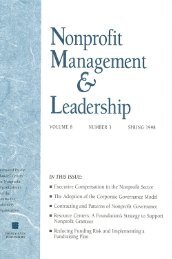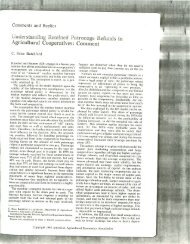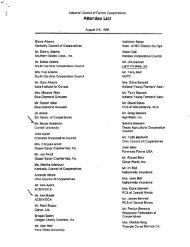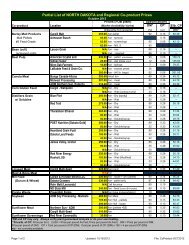Sunflower Production Field Guide - Your "Home Page"
Sunflower Production Field Guide - Your "Home Page"
Sunflower Production Field Guide - Your "Home Page"
Create successful ePaper yourself
Turn your PDF publications into a flip-book with our unique Google optimized e-Paper software.
14<br />
The nutrient content of the soil, as determined by a<br />
soil test, is the only practical way to predict probability<br />
of a response to applied nutrients (Figure 9). A soil<br />
test will evaluate the available nutrients in the soil and<br />
classify the soil as very low (VL), low (L), medium<br />
(M), high (H) or very high (VH) in certain nutrients.<br />
A fi eld classifi ed as very low in a nutrient will give a<br />
yield response to applied fertilizer 80 percent to 100<br />
percent of the time. A yield response is not always<br />
obtained because soil moisture or some other environmental<br />
factor may become limiting. A fi eld classifi ed<br />
as low will respond to applied fertilizer 40 percent<br />
to 60 percent of the time, a medium testing fi eld will<br />
respond to added fertilizer 10 percent to 20 percent<br />
of the time and a high-testing fi eld will respond to<br />
applied fertilizer only occasionally. <strong>Field</strong>s testing very<br />
high will not respond because the reserve of nutrients<br />
in the soil is adequate for optimum plant growth and<br />
performance.<br />
Fertilizer Recommendations<br />
(David Franzen)<br />
Soil tests have been developed to estimate sunfl ower’s<br />
potential response to fertilizer amendments. The most<br />
important factors in the fertilizer recommendations<br />
are the yield goal and the level of plant-available soil<br />
nutrients. In most climatic zones, predicting yield<br />
is impossible. Past yield records are a reasonable<br />
estimate of potential yield for the coming year. A yield<br />
goal for sunfl ower should be more optimistic than the<br />
average yield, and should approach the past maximum<br />
yield obtained by the grower on the same or a similar<br />
soil type. Nutrients not used by a crop in a dry growing<br />
season usually are not lost and can be used by the<br />
following crop.<br />
From an economic standpoint, having a yield goal that<br />
is somewhat high is much more benefi cial for a grower<br />
than having a goal that is too low. A low yield goal in<br />
a good growing season easily can mean lost income of<br />
$30 to $40 per acre. In contrast, a high yield goal in a<br />
dry growing season will result in a loss of only $1to<br />
$2 in additional interest on the cost of unused nutrients<br />
since most of the nutrients will be available to the<br />
subsequent crop.<br />
The amounts of nitrogen, phosphorus and potassium<br />
recommended for various sunfl ower yield goals and<br />
soil test levels are shown in Table 6. For yield goals<br />
not shown in the table, use the formulas at the base<br />
of the table. The data in this table are based on the<br />
amount of nitrate-nitrogen (NO 3 -N) in pounds per<br />
acre found in the top 2 feet of soil, the parts per million<br />
(ppm) of phosphorus (P) extracted from the top<br />
6 inches of soil by the 0.5N sodium bicarbonate, and<br />
the ppm of potassium (K) extracted by neutral normal<br />
ammonium acetate in the top 6 inches of soil<br />
Other nutrients are not usually defi cient for sunfl ower.<br />
On sandy slopes and hilltops, sulfur may be a problem;<br />
however, sulfur would not be expected to be defi -<br />
cient in higher organic matter, depressional soils. The<br />
sulfur soil test is a poor indicator of the probability of<br />
response to sulfur fertilizers. Sunfl ower has not been<br />
shown to be responsive to the application of other<br />
nutrients, including micronutrients in the state.<br />
Table 6. Nitrogen (N), phosphate (P 2 O 5 ) and<br />
potash (K 2 O) recommendations for sunfl ower in<br />
North Dakota.<br />
Yield<br />
Soil N<br />
plus<br />
fertilizer<br />
Soil Test Phosphorus, ppm<br />
VL L M H VH<br />
Goal N<br />
lb/acre-<br />
Bray-1 0-5 6-10 11-15 16-20 21+<br />
lb/acre 2 ft. Olsen 0-3 4-7 8-11 12-15 16+<br />
- - - - - - lb P2O5 /acre - - - - - -<br />
1,000 50 20 15 9 4 0<br />
1,500 75 31 22 14 5 0<br />
2,000 100 41 30 18 7 0<br />
2,500 125 51 37 23 9 0<br />
Nitrogen recommendation = 0.05 YG - STN - PCC<br />
(Bray-1) Phosphate recommendation = (0.0225-0.0011 STP)YG<br />
(Olsen) Phosphate recommendation = (0.0225-0.0014 STP)YG<br />
Yield<br />
Soil Test Potassium, ppm<br />
Goal 0-40 41-80 81-120 121-160 161+<br />
lb/acre VL L M H VH<br />
1,000 36 25 14 3 0<br />
1,500 53 37 21 5 0<br />
2,000 71 50 28 6 0<br />
2,500 89 62 35 8 0<br />
(K, ammonium acetate extractant) Potash recommendation =<br />
(0.04100-0.00027 STK)YG<br />
YG = Yield Goal<br />
PCC = Previous Crop Credit<br />
STN is the amount of NO 3 -N in the top 2 feet of soil<br />
STP, STK = Soil Test P or K, respectively<br />
VL,L,M, H,VH = very low, low, medium, high and very high,<br />
respectively







